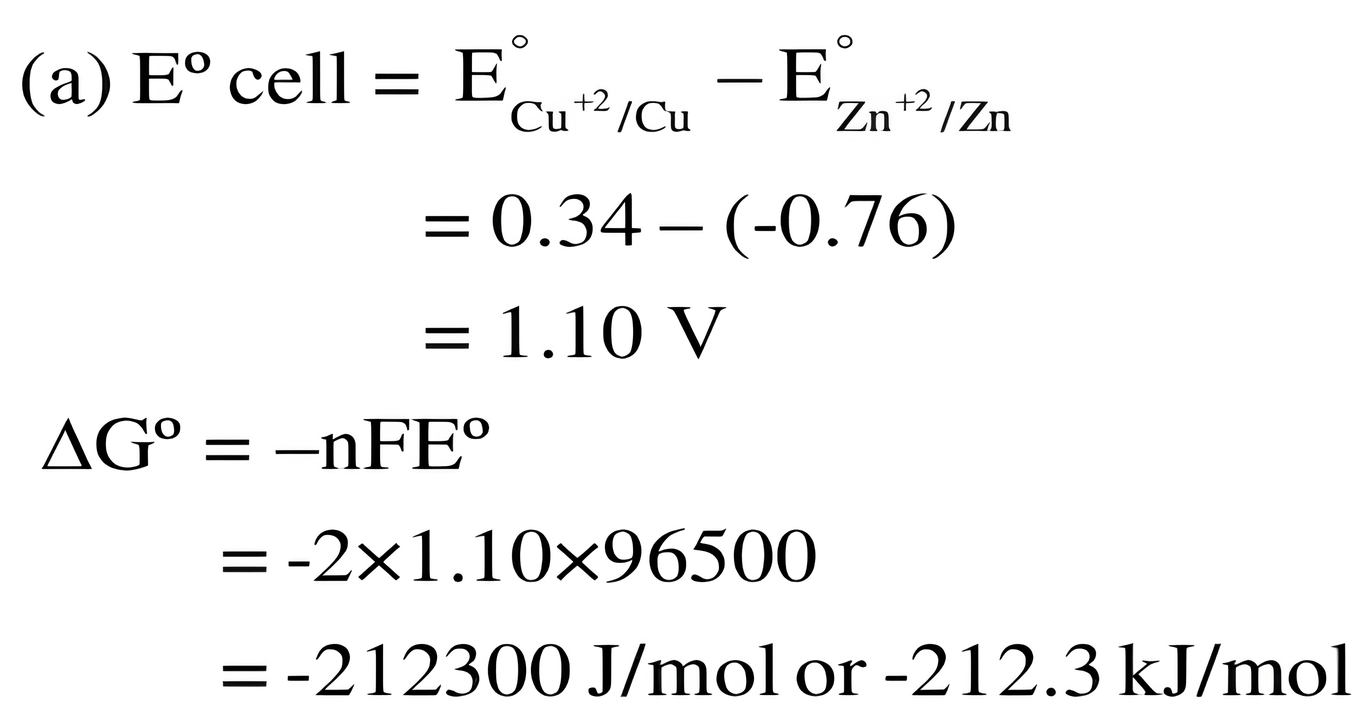(a) Calculate G° for the reaction
Zn(s) + \(Cu^{2+}\)(aq) → \(Zn^{2+}\)(aq) + Cu(s)
Given: E° for \(Zn^{2+}\)/Zn = -0.76V and E° for \(Cu^{2+}\)/Cu = +0.34 V
R = 8.314 \(JK^{–1}\) \(mol^{–1}\), F = 96500 \(mol^{–1}\)
Zn(s) + \(Cu^{2+}\)(aq) → \(Zn^{2+}\)(aq) + Cu(s)
Given: E° for \(Zn^{2+}\)/Zn = -0.76V and E° for \(Cu^{2+}\)/Cu = +0.34 V
R = 8.314 \(JK^{–1}\) \(mol^{–1}\), F = 96500 \(mol^{–1}\)

Calculate emf of the following cell
Cd/\(Cd^{2+}\) (.10 M)//\(H_+\) (.20 M)/\(H_2\) (0.5 atm)/Pt
[Given E° for \(Cd^{2+}\) /Cd = -0.403V]
How many electrons flow when a current of 5 amps is passed through a solution for 193 sec ? Given F = 96500 C. \(N_0\) = 6.002 × \(10^{23}\) \(mol^{-1}\).
How is electrical conductance of a conductor related with length and area of cross-section of the conductor?
a. G = \(l. a.k^{-1}\)
b. G = \(k. l.a^{-1}\)
c. G = \(k.a. l^{-1}\)
d. G = \(k. l.a^{-2}\)
Consider the reaction: Cr₂O₇²⁻ + 14H⁺ + 6e⁻ -> 2Cr³⁺ + 7H₂O. What is the quantity of electricity in coulombs needed to reduce 1 mol of Cr₂O₇²⁻?
Calculate pH of following half-cell. Pt, \(H_2\) / \(H_2\)\(SO_4\) , if its electrode potential is 0.03V.
The conductivity of an aqueous solution of NaCl in a cell is 92 \(Ω^{−1}\) \(cm^{-1}\) the resistance offered by this cell is 247.8 Ω . Calculate the cell constant.
The electrical resistance of a column of 0.05 M KOH solution of diameter 1 cm and length 45.5 cm is 4.55 × 10³ ohm. Calculate its molar conductivity.
Consider the reaction: Cr₂O₇²⁻ + 14H⁺ + 6e⁻ -> 2Cr³⁺ + 7H₂O. What is the quantity of electricity in coulombs needed to reduce 1 mol of Cr₂O₇²⁻?
Complete the following reactions—
(i) Cr₂O₇²⁻ + 6Fe²⁺ + 14H⁺ →
(ii) 2CrO₄²⁻ + 2H⁺ →
(iii) 2MnO₄⁻ + 5C₂O₄²⁻ + 16H⁺ →
Calculate the molar conductivity and degree of dissociation.
Conductivity of 2.5 × 10⁻⁴M methanoic acid is 5.25 × 10⁻⁵ Scm⁻¹.
Given : = 50.5Scm² mol⁻¹
Out of the following pairs, predict with reason which pair will allow greater conduction of electricity:
(i) Silver wire at 30°C or silver wire at 60°C.
(ii) 0.1 M \(CH_3\)COOH solution or 1 M \(CH_3\)COOH solution.
(iii) KCl solution at 20°C or KCl solution at 50°C.
When a certain conductance cell was filled with 0.1 M KCl, it has a resistance of 85 ohm at 25°C. When the same cell was filled with an aqueous solution of 0.052 M unknown electrolyte, the resistance was 96 ohms. Calculate the molar conductance of the electrolyte at this concentration.
[Specific conductance of 0.1 M KCl = 1.29 × 10⁻² ohm⁻¹ cm⁻¹]
Calculate emf of the following cell
Cd/\(Cd^{2+}\) (.10 M)//\(H_+\) (.20 M)/\(H_2\) (0.5 atm)/Pt
[Given E° for \(Cd^{2+}\) /Cd = -0.403V]
Give reasons :
(i) Mn shows the highest oxidation state of +7 with oxygen but with fluorine it shows the highest oxidation state of +4.
(ii) Transition metals show variable oxidation states.
(iii) Actinoids show irregularities in their electronic configurations.
